JUKI DDL-8700B-7 Instruction Manual

DDL-8700B-7
INSTRUCTION MANUAL
COVERI
|
CONTENTS |
|
I. SPECIFICATIONS........................................................................................ |
1 |
|
II. SET-UP........................................................................................................ |
3 |
|
1. |
Installation.......................................................................................................................................... |
3 |
2. |
Installing the pedal sensor............................................................................................................... |
4 |
3. |
Installing the power switch (for CE)................................................................................................ |
4 |
4. |
Connecting the connector................................................................................................................ |
5 |
5. |
How to install the power plug........................................................................................................... |
6 |
6. Attaching the connecting rod........................................................................................................... |
6 |
|
7. |
Winding the bobbin thread............................................................................................................... |
7 |
8. Adjusting the height of the knee lifter............................................................................................. |
8 |
|
9. |
Installing the thread stand................................................................................................................ |
8 |
10. |
Lubrication......................................................................................................................................... |
9 |
11. Adjusting the amount of oil (oil splashes)...................................................................................... |
9 |
|
12. Attaching the needle....................................................................................................................... |
11 |
|
13. |
Setting the bobbin into the bobbin case....................................................................................... |
12 |
14. Adjusting the stitch length............................................................................................................. |
12 |
|
15. |
Presser foot pressure..................................................................................................................... |
12 |
16. |
Hand lifter......................................................................................................................................... |
12 |
17. Adjusting the height of the presser bar......................................................................................... |
13 |
|
18. |
Threading the machine head.......................................................................................................... |
13 |
19. |
Thread tension................................................................................................................................. |
14 |
20. |
Thread take-up spring..................................................................................................................... |
14 |
21. Adjusting the thread take-up stroke.............................................................................................. |
14 |
|
22. |
Needle-to-hook relationship........................................................................................................... |
15 |
23. |
Height of the feed dog..................................................................................................................... |
15 |
24. |
Tilt of the feed dog.......................................................................................................................... |
16 |
25. Adjusting the feed timing................................................................................................................ |
16 |
|
26. |
Counter knife................................................................................................................................... |
17 |
27. |
Pedal pressure and pedal stroke................................................................................................... |
17 |
28. Adjustment of the pedal.................................................................................................................. |
18 |
|
29. |
Marker dots on the handwheel....................................................................................................... |
18 |
III. FOR THE OPERATOR............................................................................. |
19 |
|
1. |
Operating procedure of the sewing machine............................................................................... |
19 |
2. |
Setting procedure of the machine head........................................................................................ |
20 |
3. |
Operation panel built in the machine head................................................................................... |
21 |
4. |
Operating procedure of the sewing pattern.................................................................................. |
22 |
5. |
One-touch setting............................................................................................................................ |
24 |
6. |
Setting of functions......................................................................................................................... |
25 |
7. |
Production support function.......................................................................................................... |
26 |
8. |
Function setting list........................................................................................................................ |
28 |
9. |
Detailed explanation of selection of functions............................................................................. |
32 |
10. Automatic compensation of neutral point of the pedal sensor................................................... |
42 |
|
11. Selection of the pedal specifications............................................................................................. |
43 |
|
12. |
Setting of the auto lifter function................................................................................................... |
43 |
13. |
Selecting procedure of the key-lock function............................................................................... |
44 |
14. |
Initialization of the setting data...................................................................................................... |
44 |
15. |
LED hand light................................................................................................................................. |
45 |
16. |
Height adjustable one-touch type reverse stitching switch........................................................ |
45 |
IV. MAINTENANCE....................................................................................... |
46 |
|
1. Adjusting the machine head........................................................................................................... |
46 |
|
2. |
Error codes...................................................................................................................................... |
47 |
i
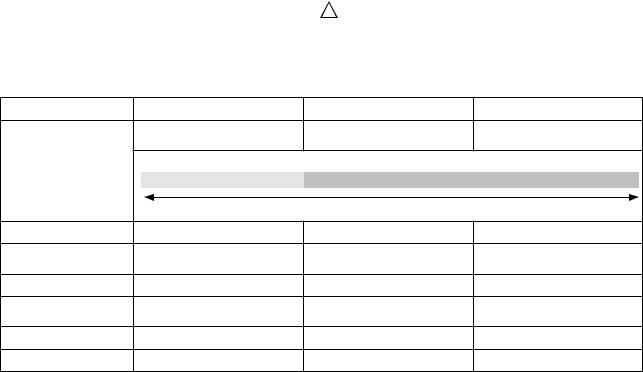
I. SPECIFICATIONS
Supply voltage |
Single phase 220 to 240V |
|
|
Frequency |
50Hz/60Hz |
Operating environ- |
Temperature : 5 to 35˚C |
ment |
Humidity 35 - 85 % or less |
Input |
210VA |
|
|
DDL-8700B - 7 |
|
|
|||
|
|
|
|
S : |
Lightto Medium-weight materials |
|
|
|
|
H : |
Heavy-weight materials |
|
|
|
|
J : |
Jeans |
|
DDL-8700BS-7 |
DDL-8700BH-7 |
DDL-8700BJ-7 |
|
|
Lightto Medium-weight |
Heavy-weight materials |
Jeans |
|
|
materials |
|||
|
|
|
||
Application |
(Schematic drawing of the applicable range) |
|
||
S type |
H type and J type |
|||
|
||||
|
Light-weight materials |
Heavy-weight materials and jeans |
||
Max. sewing speed |
5,000 sti/min |
4,000 sti/min |
4,000 sti/min |
|
Thread trimming |
300 sti/min |
300 sti/min |
300 sti/min |
|
speed |
||||
|
|
|
||
Stitch length |
4 mm |
5 mm |
5 mm |
|
Presser foot lift |
13 mm |
13 mm |
13 mm |
|
(by knee lifter) |
||||
|
|
|
||
Needle *1 |
DB x 1 (#14) #9 to 18 |
DB x 1 (#21) #20 to 23 |
DP x 5 (#21) #20 to 23 |
|
Lubricating oil |
JUKI MACHINE OIL #7 |
JUKI MACHINE OIL #7 |
JUKI MACHINE OIL #7 |
|
• The sewing speed preset at the time of shipping : 4,000sti/min.
*1 : Needle used depends on the destination.
|
- Equivalent continuous emission sound pressure level (LpA) at the workstation : |
|
|
BS-7 |
A-weighted value of 81.0 dB; (Includes KpA = 2.5 dB); according to ISO |
|
|
10821- C.6.2 -ISO 11204 GR2 at 4,000 sti/min. |
|
|
A-weighted value of 80.0 dB; (Includes KpA = 2.5 dB); according to ISO |
Noise |
|
10821- C.6.2 -ISO 11204 GR2 at 3,500 sti/min. |
|
BH-7, BJ-7 A-weighted value of 83.0 dB; (Includes KpA = 2.5 dB); according to ISO |
|
|
|
10821- C.6.2 -ISO 11204 GR2 at 4,000 sti/min. |
|
|
A-weighted value of 80.0 dB; (Includes KpA = 2.5 dB); according to ISO |
|
|
10821- C.6.2 -ISO 11204 GR2 at 3,500 sti/min. |
|
|
|
– 1 –
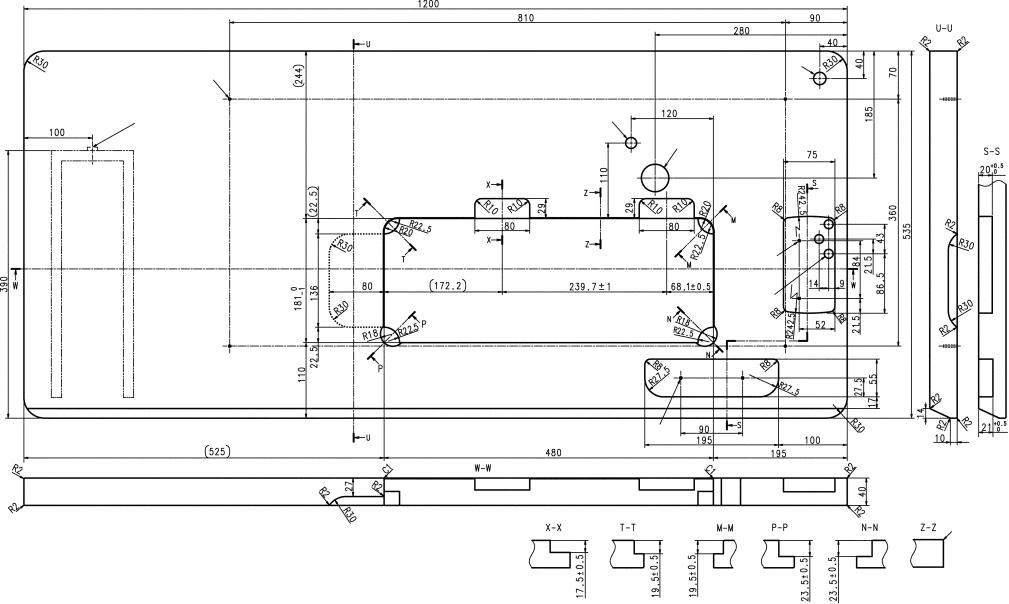
A
B
– 2 –
A 4xø3.4 on the bottom surface, depth 20 (Drill a hole at the time of set-up.) B Installing position of drawer stopper (on the reverse side)
C ø18 drilled hole D 3xø13 drilled hole E 2xø3.5, depth 10 F 2xø3.5, depth 10
G ø40±0.5 drilled hole H ø16 depth 30
I C1.5 to C2.5 (hinge side only)
C
H
G
E
D
F
I
TABLE

II.SET-UP
1.Installation
1)Carry the sewing machine with two persons as shown in the figure above.
 Do not hold the handwheel.
Do not hold the handwheel.
|
|
|
|
|
|
|
|
2)Do not put protruding articles such as the screwdriver and the like at the location where the sewing machine is placed.
3)Adjust so that the oil pan is supported at the four corners of the table. Mount rubber hinge seat on the table and fix it on the table with a nail.
23.5mm |
19.5mm |



A B
4)Two rubber seats for supporting the head por-
tion on the operator side A are fixed on the extended portion of the table by hitting the nail , and the other two rubber cushion seats on the
hinge side B are fixed by using a rubber-based adhesive. Then, oil pan is placed.
C
|
|
|
|
5)Fit knee lifter pressing rod . Fit hinge into the opening in the machine bed, and fit the machine head to table rubber hinge before placing the machine head on cushions on the four corners.
6)Securely attach head support rod to the table until it goes no further.
1.Be sure to install the machine head support bar supplied with the unit.
2.If a pair of scissors or the like is caught between the control box and the table, the control box cover can break. To prevent such an accident, do not place anything on C section.
– 3 –
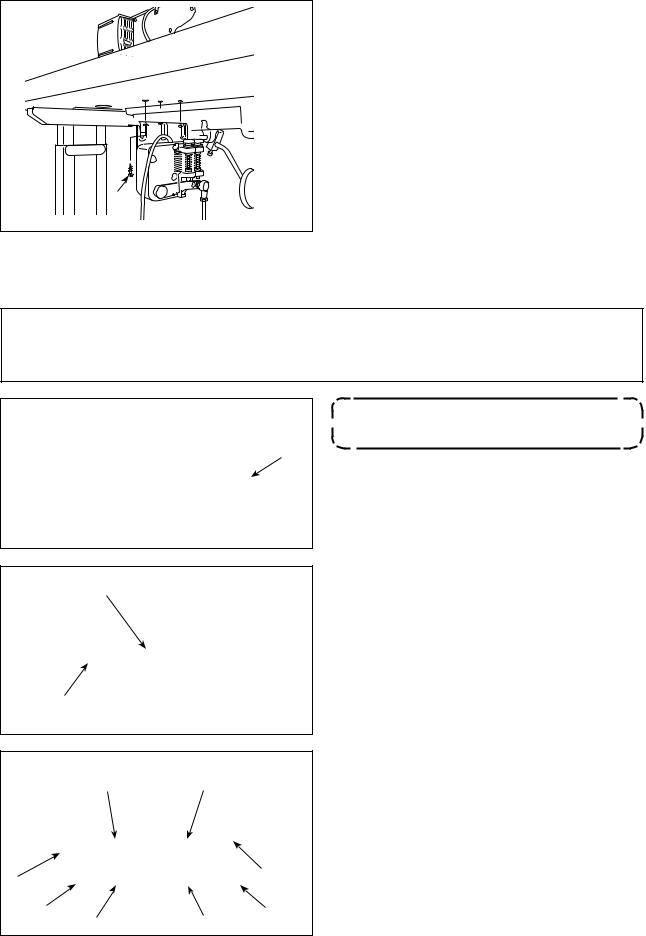
2. Installing the pedal sensor
1) Install the pedal sensor to the table with mounting
screws supplied with the unit.
It is necessary to install the pedal sensor at such a position that the connecting rod is perpendicular to the table.
2) After the completion of installation of the pedal
sensor on the table, place the sewing machine head on the table.
3. Installing the power switch (for CE)
WARNING :
1.Be sure to attach the ground wire (green/yellow) to the specified location (on the ground side).
2.Take care not to allow terminals to come in contact with each other.
3.When closing the power switch cover, take care not to allow the cord to be caught under it.
1ø 220V-240V
Blue Blue
|
|
Green/ |
|
|
Yellow |
||
|
|
||
Green/ |
|
|
|
Yellow |
|
||
Brown |
Brown |
||
|
Do not insert the power plug into the plug receptacle.
1)Remove screw on the side face of the power switch cover to open the power switch cover.
2)Pass AC input cord (40145128),(M6102461DAA) through the rear face of the
power switch. Bundle the cord with cable clip band to secure it.
3)Securely fix the terminals of the AC input cord
(40145128), (M6102461DAA) by tightening the screws at the specified locations.
4)Close the power switch cover. Tighten screw on the side face of the power switch cover.
– 4 –
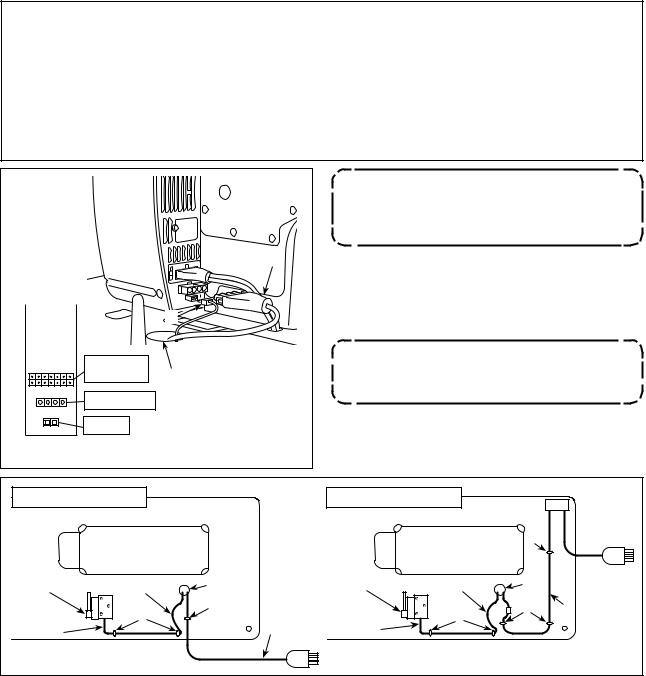
4. Connecting the connector
WARNING :
•To protect against personal injury resulting from abrupt start of the sewing machine, be sure to turn the power OFF, unplug the machine and wait for five minutes or more before installing the pedal sensor.
•To prevent damage of device caused by maloperation and wrong specifications, be sure to connect all the corresponding connectors to the specified places. (If any of the connectors is inserted into a wrong connector, not only the device corresponding to the connector can break but also it can start abruptly, inviting the risk of personal injury.)
•To prevent personal injury caused by maloperation, be sure to lock the connector with lock.
•As for the details of handling respective devices, read carefully the Instruction Manuals supplied with the devices before handling the devices.
|
|
|
Do not insert the power plug into the wall |
|
|
|
outlet. |
|
|
|
Check to be sure that the power switch is |
|
|
|
turned OFF. |
|
|
1) Connect pedal sensor cable and AC input |
|
|
|
|
cable supplied with the machine to the control |
|
|
|
box. For the connection ports of the cables, refer |
|
|
to the connector layout drawing. |
|
|
|
|
|
Machine head |
|
|
Be sure to fully insert the connectors into |
|
|
the corresponding ports until they are |
|
connector |
|
||
AC power supply |
|
|
locked. |
|
|
|
|
Pedal |
|
2) |
Draw out cable of the control box through cable |
|
|
draw-out hole to route it to the underside of |
|
Connector connection diagram |
|
||
|
the sewing machine table. |
||
|
|
|
|
Underside of the table |
|
Underside of the table |
|
|
|
|
|
Pedal sensor |
Slack |
|
|
Pedal sensor |
Slack |
|
|
|
|
|
|
|
|
|
|
|
|
|
|
|
|
||
|
|
|
|
|
(For CE)
3) Fix pedal sensor cable and AC input cable with a staple .
– 5 –
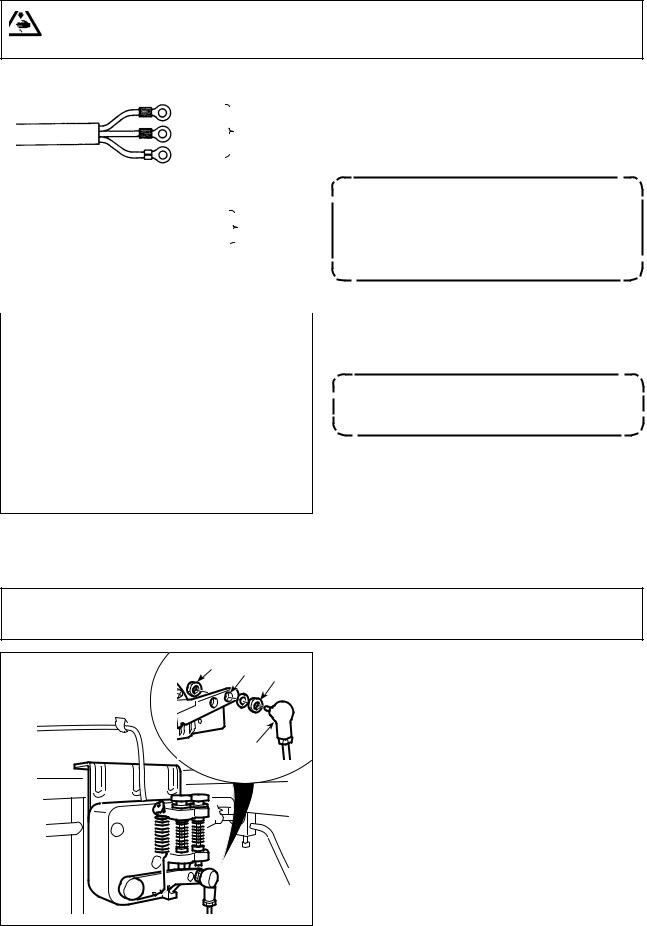
5. How to install the power plug
WARNING :
1.Be sure to attach the ground wire (green/yellow) to the specified location (on the ground side).
2.Take care not to allow terminals to come in contact with each other.
|
|
|
|
|
1) Connect the power cord to power plug . Con- |
|
3ø 200-240V |
|
|
|
|
||
Black |
|
|
|
|
nect the black, red and while wires (3 ø) and the |
|
|
|
|
|
|
||
|
|
|
|
|
blue and brown wires (1 ø) to the power supply |
|
|
Red |
|
|
AC |
|
|
|
|
|
|
side and the green/yellow wire to the earth side |
||
|
White |
|
|
200-240V |
|
|
|
Green / Yellow |
|
as illustrated in the figure. |
|||
|
|
|
||||
1ø 220-240V |
(ground wire) |
|
1. Be sure to prepare the power plug |
|||
|
|
|
|
|
which conforms to the safety stan- |
|
(For CE) |
Blue |
|
AC |
|
||
|
|
|||||
|
|
dard. |
||||
|
Brown |
|
220-240V |
|
||
|
|
|
||||
|
|
|
2. Be sure to connect the ground lead |
|||
|
Green / Yellow |
|
||||
|
|
(green/yellow) to the grounding side. |
||||
|
(ground wire) |
|
||||
|
|
|
||||
|
|
|
|
|
2) |
Check that the power switch is in the OFF state. |
|
|
|
|
|
||
|
|
|
|
|
||
|
|
|
|
|
|
Then, insert the power plug coming from the |
|
|
|
|
|
|
power switch into the plug receptacle. |
|
|
|
|
|
|
In prior to the connection of the power |
|
|
|
|
|
|
plug , re-check the supply voltage spec- |
ification indicated on the control box.
*The power plug is different in shape according to the destination of the sewing machine.
6.Attaching the connecting rod
WARNING :
To protect against possible personal injury due to abrupt start of the machine, be sure to start the following work after turning the power off and a lapse of 5 minutes or more.
|
|
|
|
||
|
|
|
|
|
|
Fix connecting rod to installing hole of pedal leverwith nut .
– 6 –
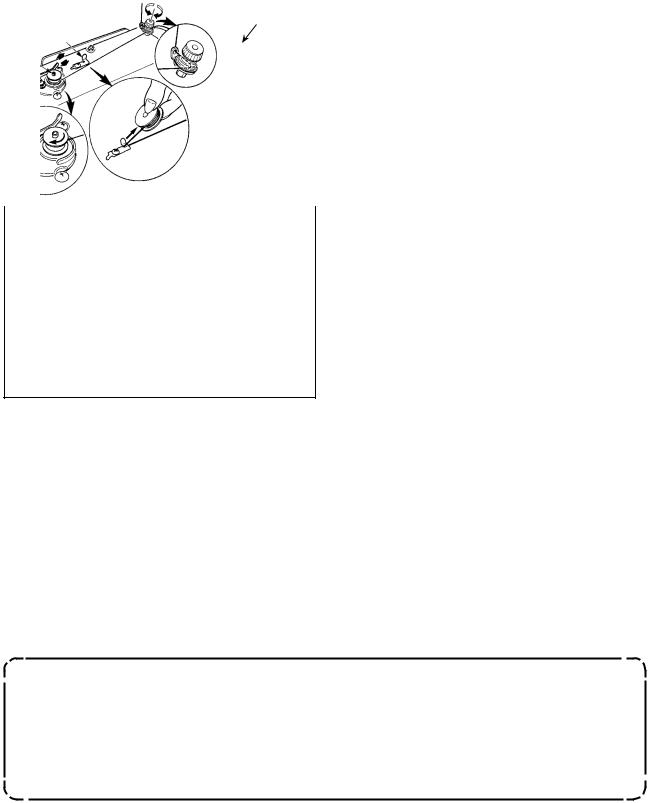
7. Winding the bobbin thread
|
|
|
|
1) |
Insert the bobbin deep into the bobbin winder |
|
|
|
|
||
|
|
|
spindle until it will go no further. |
||
|
2) Pass the bobbin thread pulled out from the |
||||
B |
|
|
spool rested on the right side of the thread stand |
||
|
A |
|
|
|
following the order as shown in the figure on the |
|
|
|
|
|
|
|
|
|
left. Then, wind clockwise the end of the bobbin |
||
|
|
thread on the bobbin several times. |
|||
|
C |
|
|
(In case of the aluminum bobbin, after winding |
|
|
|
|
|
|
|
|
|
|
clockwise the end of the bobbin thread, wind |
||
|
|
|
|
|
counterclockwise the thread coming from the |
|
|
|
|
|
bobbin thread tension several times to wind the |
|
|
|
|
|
|
|
|
|
|
|
bobbin thread with ease.) |
|
|
|
3) |
Press the bobbin winder trip latch in the direc- |
|
|
|
|
|
||
|
|
|
|
tion of A and start the sewing machine. The bob- |
|
|
|
|
D |
|
|
|
|
|
|
|
bin rotates in the direction of C and the bobbin |
|
|
|
|
thread is wound up. The bobbin winder spindle |
|
|
|
|
|
|
|
|
|
|
|
automatically as soon as the winding is finished. |
|
|
|
|
E |
|
|
|
|
|
|
4) Remove the bobbin and cut the bobbin thread |
|
|
|
|
|
|
with the thread cut retainer . |
5) When adjusting the winding amount of the bobbin thread, loosen setscrew and move bobbin winding lever to the direction of A or B. Then tighten setscrew .
To the direction of A : Decrease To the direction of B : Increase
6)In case that the bobbin thread is not wound evenly on the bobbin, loosen screw and adjust the height of bobbin thread tension .
•It is the standard that the center of the bobbin is as high as the center of thread tension disk .
•Adjust the position of thread tension disk to the direction of D when the winding amount of the bobbin thread on the lower part of the bobbin is excessive and to the direction E when the winding amount of the bobbin thread on the upper part of the bobbin is excessive.
After the adjustment, tighten screw .
7)To adjust the tension of the bobbin winder, turn the thread tension nut .
1.When winding the bobbin thread, start the winding in the state that the thread between the bobbin and thread tension disk is tense.
2.When winding the bobbin thread in the state that sewing is not performed, remove the needle thread from the thread path of thread take-up and remove the bobbin from the hook.
3.There is the possibility that the thread pulled out from the thread stand is loosened due to the influence (direction) of the wind and may be entangled in the handwheel. Be careful of the direction of the wind.
– 7 –

8. Adjusting the height of the knee lifter
WARNING :
Be sure to turn the power OFF before the following work in order to prevent personal injury due to unintentional starting of the sewing machine.
|
1) |
The standard height of the presser foot lifted |
|
|
using the knee lifter is 10 mm. |
2) |
You can adjust the presser foot lift up to 13 mm |
|
|
using knee lifter adjust screw . |
|
3) |
When you have adjusted the presser foot lift |
|
|
|
to over 10 mm, be sure that the bottom end of |
|
|
needle bar in its lowest position does not hit |
|
|
presser foot . |
9. Installing the thread stand
1) Assemble the thread stand unit, and insert it in the hole in the machine table.
2) Tighten nut .

– 8 –

10. Lubrication
WARNING :
1.Do not connect the power plug until the lubrication has been completed so as to prevent accidents due to abrupt start of the sewing machine,
2.To prevent the occurrence of an inflammation or rash, immediately wash the related portions if oil adheres to your eyes or other parts of your body.
3.If oil is mistakenly swallowed, diarrhea or vomitting may occur. Put oil in a place where children cannot reach.
|
Before starting the sewing machine, fill oil pan |
|
|
1) |
|
|
|
with JUKI MACHINE OIL #7 up to “HIGH” mark |
|
|
A. |
|
2) |
Add oil before the oil surface comes down to |
|
|
reach the “LOW” mark B. |
|
3) |
When you operate the machine after lubrication, |
|
|
you will see splashing oil through oil sight window |
|
if the lubrication is adequate. |
|
|
|
|
|
4) |
Note that the amount of the splashing oil is unre- |
|
|
lated to the amount of the lubricating oil. |
|
|
|
1.When you use a new sewing machine or a sewing machine after an extended period of disuse, use the sewing machine after performing break-in at 2,000 sti/min or less.
2.For the oil lubrication, purchase JUKI NEW DEFRIX OIL No. 1 (Part No. : MDFRX1600C0) or JUKI MACHINE OIL #7 (Part No. : MML007600CA).
3.Be sure to lubricate clean oil.
4.When the oil surface is lower than the LOW mark, the oiling may be inconsistent. To prevent inconsistent oiling, add oil before the oil surface comes down to reach the LOW mark.
11.Adjusting the amount of oil (oil splashes)
WARNING :
Be extremely careful about the operation of the machine since the amount of oil has to be checked by turning the hook at a high speed.
(1) Confirmation of the amount of oil in the hook
Amount of oil (oil splashes) confirmation paper |
Position to confirm the amount of oil (oil splashes) |
|
mm |
-10 mm |
|
25 |
3 |
|
Oil splashes confirmation |
against the wall |
|
|
|
surface of the bed. |
*When carrying out the procedure described below in 2), remove the slide plate and take extreme caution not to allow your fingers to come in contact with the hook.
1)If the machine has not been sufficiently warmed up for operation, make the machine run idle for approximately three minutes. (Moderate intermittent operation)
2)Place the amount of oil (oil spots) confirmation paper under the hook immediately after the machine stops running.
3)Confirm the height of the oil surface in the oil reservoir is within the range between “HIGH” and “LOW”.
4)Confirmation of the amount of oil should be completed in five seconds. (Check the period of time with a watch.)
–9 –

(2)Adjusting the amount of oil (oil spots) in the hook
1)Turning the oil amount adjustment screw at-
tached on the hook driving shaft front bushing in the “+” direction (in direction A) will increase the amount of oil (oil spots) in the hook, or in the “–”
|
B |
direction (in direction B) will decrease it. |
|
A |
2) After the amount of oil in the hook has been |
||
|
|||
|
|
properly adjusted with the oil amount adjustment |
|
|
|
screw, make the sewing machine run idle for |
|
|
|
approximately 30 seconds to check the amount |
|
|
|
of oil in the hook. |
(3) Sample showing the appropriate amount of oil in the hook
Appropriate amount of oil (small) Splashes of oil from the hook
1 mm
Appropriate amount of oil (large) Splashes of oil from the hook
* mm
 * mm
* mm
DDL-8700BS-7 2 mm
DDL-8700BH-7 3 mm
DDL-8700BJ-7
1)The amount of oil shown in the samples on the left should be finely adjusted in accordance with sewing processes. Be careful not to excessively increase/decrease the amount of oil in the hook. (If the amount of oil is too small, the hook will be seized (the hook will be hot). If the amount of oil is too much, the sewing product may be stained with oil.)
2)Check the oil amount (oil splashes) three times (with three sheets of paper).
(4) Confirmation of the amount of oil supplied to the face plate parts
Amount of oil (oil splashes) confirmation paper
25 mm
Position to confirm the amount of oil
(oil splashes)
Oil splashes  confirmation paper
confirmation paper
*When carrying out the work described below in 2), remove the face plate and take extreme caution not to allow your fingers to come in contact with the thread take-up lever.
1)If the machine has not been sufficiently warmed up for operation, make the machine run idle for approximately three minutes. (Moderate intermittent operation)
2)Place the amount of oil (oil spots) confirmation paper under the hook immediately after the machine stops running.
3)Confirm the height of the oil surface in the oil reservoir is within the range between “HIGH” and “LOW”.
4)The time required for the confirmation of the amount of oil (oil splashes) should be completed in ten seconds. (Measure the period of time with a watch.)
– 10 –

(5)Adjusting the amount of oil supplied to the face plate parts
1)Adjust the amount of oil supplied to the thread take-up and needle bar crank by turning adjust pin .
C |
B |
A |
2) The minimum amount of oil is reached when |
|
|
marker dot A is brought close to needle bar |
|
|
|
|
|
|
|
crank by turning the adjust pin in direction B. |
|
|
3) The maximum amount of oil is reached when |
||
Maximum |
Minimum |
|
|
|
marker dot A is brought to the position just |
||
|
|
|
|
|
|
opposite from the needle bar crank by turning the |
|
|
|
|
|
|
|
|
adjust pin in direction C. |
(6) Sample showing the appropriate amount of oil supplied to the face plate parts
Appropriate amount of oil (small)
Splashes of oil from the thread take-up lever
1 mm
Appropriate amount of oil (large)
Splashes of oil from the thread take-up lever
1)The state given in the figure shows the appropriate amount of oil (oil splashes). It is necessary to finely adjust the amount of oil in accordance with the sewing processes. However, do not excessively increase/decrease the amount of oil in the hook. (If the amount of oil is too small, the face plate parts will be hot or seize. If the amount of oil is too much, the sewing product may be stained with oil.)
2)Check the oil amount (oil splashes) three times (with three sheets of paper).
2 mm
12. Attaching the needle
WARNING :
Be sure to turn the power OFF before the following work in order to prevent personal injury due to unintentional starting of the sewing machine.
|
|
|
|
Use the specified needle for the machine. Use the |
|
|
|
|
|
||
|
|
|
|
proper needle in accordance with the thickness of |
|
|
D |
B |
|
thread used and the kinds of the materials. |
|
|
|
|
|
1) |
Turn the handwheel until the needle bar reaches |
|
|
|
A |
|
the highest point of its stroke. |
|
C |
|
2) Loosen screw , and hold needle with its |
||
|
|
|
|||
|
|
|
|
indented part A facing exactly to the right in |
|
|
|
|
|
|
|
|
|
|
|
|
direction B. |
|
|
|
|
3) |
Insert the needle fully into the hole in the needle |
|
|
|
|
|
bar in the direction of the arrow until the end of |
|
|
|
|
|
hole is reached. |
|
|
|
|
4) |
Securely tighten screw . |
|
|
|
|
||
|
|
|
|
5) |
Check that long groove C of the needle is facing |
|
|
|
|
|
exactly to the left in direction D. |
When polyester filament thread is used, if the indented part of the needle is tilted toward operator's side, the loop of thread becomes unstable. As a result, hangnail of thread or thread breakage may occur. For the thread that such phenomenon is likely to occur, it is effective to attach the needle with its indented part slightly slanting on the rear side.
– 11 –
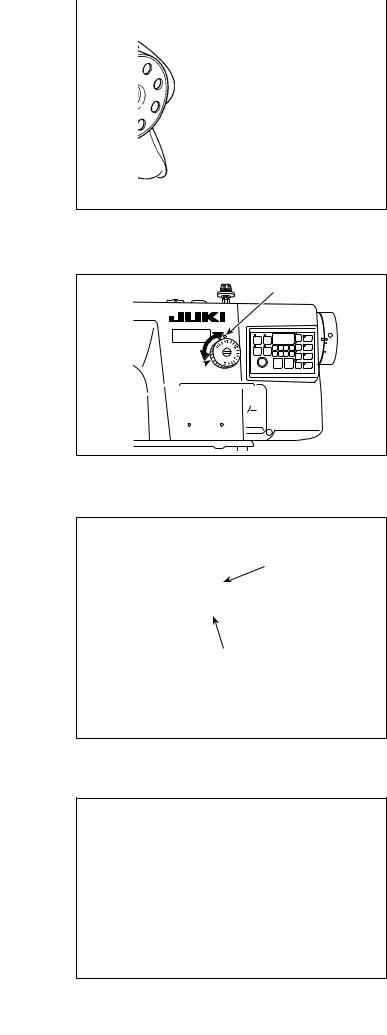
13. Setting the bobbin into the bobbin case
|
1) |
Pass the thread through thread slit A, and pull |
|
||
A |
the thread in direction C. By so doing, the thread |
|
|
|
|
|
|
will pass under the tension spring and come out |
|
|
from notch B. |
2) |
Check that the bobbin rotates in the direction of |
|
B |
the arrow when thread is pulled. |
|
|
||
C
14. Adjusting the stitch length
A



*The dial calibration is in millimeters (reference value).
1)Turn stitch length dial in the direction of the
arrow, and align the desired number to marker dot A on the machine arm.
15. Presser foot pressure
B A
29 to 32 mm
1)Loosen nut . As you turn presser spring regulator clockwise (in direction A), the presser foot pressure will be increased.
2)As you turn the presser spring regulator count- er-clockwise (in direction B), the pressure will be decreased.
3)After adjustment, tighten nut .
The standard value of the pressure regulating thumb screw is 29 to 32 mm.
16. Hand lifter
1) The presser foot is lifted by moving the lever upward.
2) The presser foot is lowered by moving the lever downward.
– 12 –

17. Adjusting the height of the presser bar
WARNING :
Be sure to turn the power OFF before the following work in order to prevent personal injury due to unintentional starting of the sewing machine.
|
1) |
Loosen setscrew , and adjust the presser bar |
|
||
|
|
height or the angle of the presser foot. |
|
2) |
After adjustment, securely tighten the setscrew |
|
|
. |
|
|
|
18. Threading the machine head
WARNING :
Be sure to turn the power OFF before the following work in order to prevent personal injury due to unintentional starting of the sewing machine.
– 13 –

19. Thread tension
B A E F
C
D
(1) Adjusting the needle thread tension
1)The length of thread remaining at the needle tip
after thread trimming is shortened by turning tension regulating nut No. 1 clockwise in direction
A.
2)It is lengthened by turning the nut counterclockwise in direction B.
3)The needle thread tension is increased by turning tension regulating nut No. 2 clockwise in direction C.
4)It is decreased by turning the nut counterclockwise in direction D.
(2) Adjusting the bobbin thread tension
1)The bobbin thread tension is increased by turning tension regulating screw clockwise in direction
E.
2)It is decreased by turning the screw counterclockwise in direction F.
20. Thread take-up spring
A
B
|
|
|
(1) Changing the stroke of thread take-up spring
1)Loosen setscrew .
2)As you turn tension post clockwise (in direction A), the stroke of the thread take-up spring will be increased.
3)As you turn tension post counterclockwise (in direction B), the stroke will be decreased.
(2) Changing the pressure of thread take-up spring
1)Loosen setscrew , and remove thread tension asm. .
2)Loosen setscrew .
3)As you turn tension post clockwise (in direction A), the pressure will be increased.
4)As you turn the tension post counterclockwise (in direction B), the pressure will be decreased.
21. Adjusting the thread take-up stroke
WARNING :
Be sure to turn the power OFF before the following work in order to prevent personal injury due to unintentional starting of the sewing machine.
|
1) When sewing heavy-weight materials, move |
||
|
|||
A B |
|
thread guide to the left (in direction A) to |
|
|
|
increase the length of thread pulled out by the |
|
|
thread take-up. |
||
|
|
||
C |
2) When sewing light-weight materials, move thread |
||
|
guide to the right (in direction B) to decrease |
||
|
|
the length of thread pulled out by the thread take- |
|
|
|
up. |
|
|
3) |
Normally, thread guide is positioned in a way |
|
|
|
that marker line C is aligned with the center of |
|
|
|
the screw. |
|
– 14 – |
|||
|
|||
